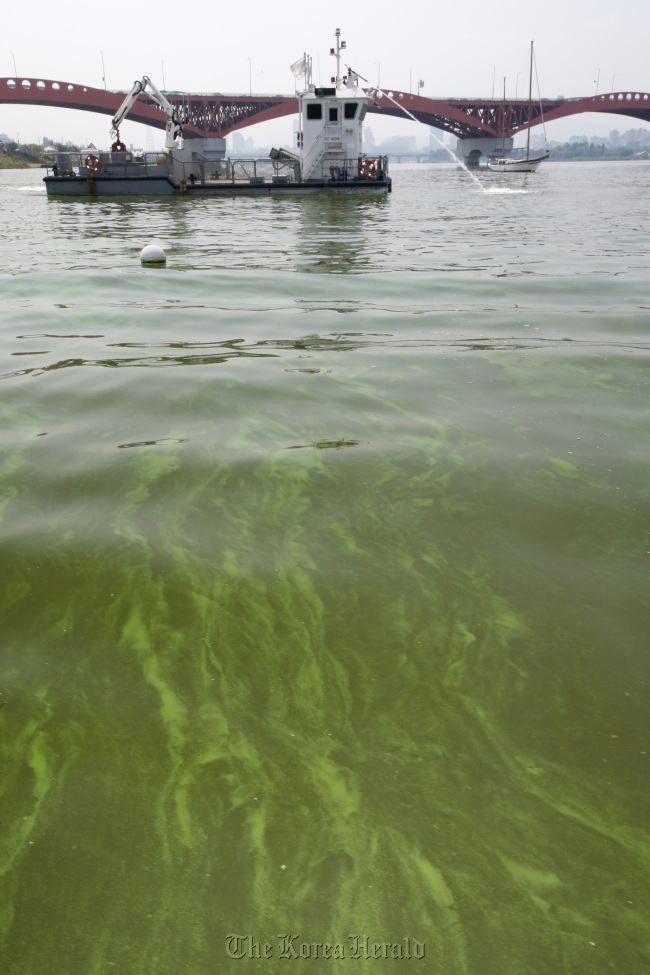A thick green tide spreading across Korea’s major rivers due to low water flow and warm temperatures is stoking concerns over the ecosystem and public health.
Since mid-May, algal blooms have been seen in the Nakdonggang River in the south of the peninsula.
In June, the algal blooms spread in the Hangang River in Seoul as well, and Seoul Metropolitan Government issued an algal bloom warning on June 30 in the downstream section of the river, spanning from Jamsil Bridge to Haengju Bridge. It was the first such warning in 15 years.

Green algal blooms are considered harmful as they can block water flow and cause odors, affecting the ecosystem. The blue-green algae even contains toxic substances that can cause respiratory problems or paralysis in humans.
The algae warning is issued when the cell count of blue-green algae exceeds 5,000 cells per milliliter and over 25 milligrams per milliliter of chlorophyll A. The blue-green algae level around Seongsan Bridge recorded 27,000 cells, officials said.
The toxic substance microcystin-LR was already detected in some spots along the Hangang River exceeding the safety threshold level of 1 microgram per liter, they added.
The continuous drought and high temperatures have contributed to the algae occurrence, experts said.
“Algal blooms usually proliferate in the summer when the water temperature goes up and there is enough sunshine. This summer, the spread was made easier as the discharge flow from Paldang Dam decreased due to the drought, leaving the water to remain stagnant in the river,” environment engineering professor Choi Suing-il at Korea University told The Korea Herald.
The discharge flow from Paldang Dam last month plummeted by 56 percent compared to last year, Seoul City said.
The government and municipalities have carried out emergency preventive measures to contain the algae while strengthening monitoring.
Despite the efforts, the green tide is still expanding. The algae warning alert on the Hangang River in Seoul was extended to Mapo Bridge and Hangang Bridge on Friday.
Public concerns are consequently growing over the algae’s impact on drinking water. The Hangang River and Nakdonggang River are the main water sources for nearby residents.
Experts, however, stressed that water was safe unless it had been directly exposed to the green tide, the authorities said.
“Major water treatment facilities in the country are equipped with advanced water treatment systems. This system carries ozone and granular activated carbon that completely eliminate all pollutants as well as their odors and bad taste,” Choi added. “There will be no impact on our drinking water.”
The government, however, warned the public not to carry out recreational water activities such as fishing or water skiing in river sections where alerts had been issued, as direct exposure to the algae can trigger skin irritation.
The government anticipates that the upcoming rain will likely relieve the algae spread as a typhoon is expected to hit the peninsula from Tuesday to Thursday.
By Lee Hyun-jeong (rene@heraldcorp.com)







![[KH Explains] How should Korea adjust its trade defenses against Chinese EVs?](http://res.heraldm.com/phpwas/restmb_idxmake.php?idx=644&simg=/content/image/2024/04/15/20240415050562_0.jpg&u=20240415144419)










![[Today’s K-pop] Stray Kids to return soon: report](http://res.heraldm.com/phpwas/restmb_idxmake.php?idx=642&simg=/content/image/2024/04/16/20240416050713_0.jpg&u=)